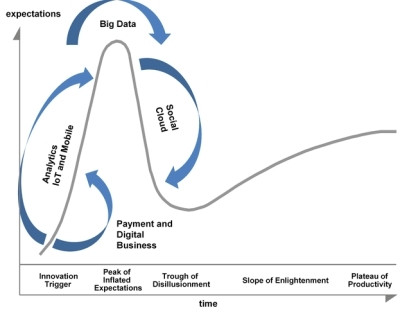
As research firm Gartner readies its annual technology Hype Cycle, it has noted numerous points IT leaders and chief information officers (CIOs) should take note of when dissecting trends.
The firm says its Hype Cycle provides a representation of the maturity and adoption of technologies and applications, and how they are potentially relevant to solving real business problems and exploiting new opportunities.
It looks at how trends evolve over time. Depending on how Gartner analysts view their development, they are placed at one of the following points on a graph, which moves from the start of a trend, to its usefulness: technology trigger, a peak of inflated expectations, the trough of disillusionment, slope of enlightenment, or the plateau of productivity.
The following trends have been identified by the company as most relevant to CIOs:
Emerging technologies
Gartner says this element of its Hype Cycle focuses on technologies that will have the highest impact on organisations that are moving toward digital marketing, digital business and autonomous computing. "Digital marketing focuses on new and more sophisticated ways to reach consumers, who are more willing to participate in marketing efforts to gain greater social connection, or product and service value," the firm says.
Digital business, meanwhile, focuses on the convergence of people, business and things.
IT operations management (ITOM)
According to Gartner, IT leaders need to pay close attention to "dual-speed" or "bimodal operations" emerging in many IT organisations that aim to meet the need to operate IT at two speeds.
The first is to support reliable and steadfast ITOM processes and technologies, and another to support the operations management of new and innovative technologies. "More than a third of the profiles continue to be represented in the 'trough of disillusionment'; most of these are gradually moving toward the plateau. But several profiles placed on the 'innovation trigger' are composed of technologies, process frameworks, and approaches to managing emerging applications and supporting infrastructure."
The firm notes that influences in ITOM include cloud and agile development projects, particularly for the delivery of applications and services, and by the Gartner-named 'nexus of forces' of social, mobile and cloud, which help IT operations enable flexible styles of computing and user experiences.
Big
There has been an overall shift of big data over the 'peak of inflated expectations', which aligns with Gartner's analysis of its 'big-mover' elements of its cycle. The firm says this aspect of IT has generally moved into of the trough of disillusionment, although the shift is not universal.
"The adoption of big data technologies, services and disciples has increased and has resulted in their first successes and failures; hence, the profiles have passed over the peak of hype. This hype cycle also predicts the rapid and 'brutal' shift into the trough of disillusionment and the emergence of robust and enterprise-ready solutions and implementations.
Cloud
Since most enterprises and consumers are using some cloud services, says Gartner, this aspect of the hype cycle is important for both users and vendors. Cloud - one of "the most hyped terms in the history of IT" - is continuing to change buying behaviours and influence other megatrends, such as mobile, digital business and big data.
Gartner adds that organisations need a broader perspective on the 'cloud washing' phenomenon by vendors, who continue to jump on the cloud bandwagon with anything they can label 'cloud'.
While users may be experiencing a bit of 'cloud fatigue' due to media news on outages and questions about security and privacy, it has become pervasive and will continue to evolve to provide agility and innovation, which is critical for supporting current business operations, as well as for doing digital business.
Internet of things (IOT)
IOT represents many emerging technologies and standards that are enabling digital business. "IT leaders, regardless of industry, size or region, should not ignore this trend because they feel that their primary focus is on 'enterprise' systems," says Gartner.
IOT is becoming a "vibrant part" of the business and IT landscape, and Gartner notes understanding how this part of the hype cycle plays out will explore the impact of IOT on public and industry-sector organisations, as well as business-centric and customer-centric organisations.
This technology also links to some of the research firm's other hypes, including smart city technologies, vehicle ICT and operational technology.
Share